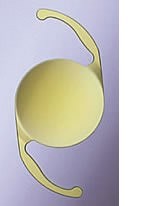Astigmatism occurs when the cornea is shaped more like a football rather than a soccer ball. Most astigmatic corneas have two curves—a steeper curve and a flatter curve. This causes light to focus on more than one point in the eye, resulting in blurred vision at distance and near. Uncorrected astigmatism causes ghosting or shadowed images. Astigmatism can be corrected surgically or with glasses or contacts. The most common surgeries to correct astigmatism are Limbal Relaxing Incisions (procedures that involve placing microscopic incisions on the cornea), LASIK, PRK and astigmatism reducing intraocular toric lens implants. Limbal Relaxing Incisions (LRI), Trulign toric accommodating intraocular lens implants, Restor multifocal toric lens and toric monofocal intraocular lens implants can be used during cataract surgery to reduce astigmatism. This helps you achieve better vision without glasses.
Remember, these lens are good for life.
Astigmatism Correcting Procedures and Implants
Limbal Relaxing Incision
Limbal Relaxing Incision (LRI) is a surgical procedure to treat astigmatism. It is often combined with cataract surgery to reduce pre-existing astigmatism. The result is better vision without glasses. During surgery tiny incisions are placed on the periphery of the cornea (called the limbus) resulting in a cornea that is more rounded. The procedure can be completed in a few minutes. There is usually little if any post-operative discomfort.
Limbal relaxing incisions have gained widespread acceptance among cataract surgeons, resulting in better post-operative vision without glasses. The procedure can also be performed separate from cataract surgery in individuals whose primary refractive error is astigmatism.
Monofocal Toric IOLs
 Another option to reduce astigmatism are monofocal toric intraocular lens (IOLs). These lens reduce the patient’s need for glasses in the distance. In fact the patient may only need over the counter reading glasses. Without this lens, patients would need prescription glasses for distance and prescription glasses to read. There is a big difference between needing prescription reading glasses and over the counter reading glasses.
Another option to reduce astigmatism are monofocal toric intraocular lens (IOLs). These lens reduce the patient’s need for glasses in the distance. In fact the patient may only need over the counter reading glasses. Without this lens, patients would need prescription glasses for distance and prescription glasses to read. There is a big difference between needing prescription reading glasses and over the counter reading glasses.
TRULIGN™
Trulign lens are an “accommodating, toric” intraocular lens. In English, this means that the lens flexes and bends in the eye to focus up close. This lens also has the added benefit of correcting astigmatism. Unlike other IOLs that help patient’s focus up close, this lens does not produce any increases in glare at night.
Restor Multifocal Toric Lens
The Restor Toric Multifocal lens gives patients the greatest range in vision. Patients are typically able to see both in the distance and up close without glasses. Patients may need over the counter reading glasses to read fine print or to read in dimly lit situations. Though patient’s typically enjoy this lens the most compared to all of the other lens, not every patient qualifies for this lens.
Dr. Stuart Kaufman and Dr. Jonathan Kaufman will evaluate your eyes and discuss which lens are best suited for your unique eyes and lifestyle.


